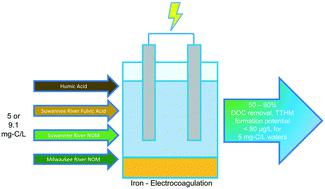当前位置:
X-MOL 学术
›
Environ. Sci.: Water Res. Technol.
›
论文详情
Our official English website, www.x-mol.net, welcomes your
feedback! (Note: you will need to create a separate account there.)
Iron-electrocoagulation as a disinfection byproduct control strategy for drinking water treatment
Environmental Science: Water Research & Technology ( IF 3.5 ) Pub Date : 2020-02-24 , DOI: 10.1039/d0ew00106f Donald R. Ryan 1, 2, 3, 4 , Patrick J. McNamara 1, 2, 3, 4 , Brooke K. Mayer 1, 2, 3, 4
Environmental Science: Water Research & Technology ( IF 3.5 ) Pub Date : 2020-02-24 , DOI: 10.1039/d0ew00106f Donald R. Ryan 1, 2, 3, 4 , Patrick J. McNamara 1, 2, 3, 4 , Brooke K. Mayer 1, 2, 3, 4
Affiliation

|
Disinfection byproducts (DBPs) result from reactions between oxidizing disinfectants, e.g., free chlorine, and DBP precursors such as natural organic matter (NOM). Electrocoagulation (EC) has potential as an effective DBP precursor removal strategy for decentralized water treatment and small drinking water utilities as it features similar removal trends compared to conventional coagulation, without alkalinity consumption, while also generating coagulant in situ by anodic dissolution of iron electrodes. However, studies assessing DBP formation in drinking water following EC treatment are lacking. This research evaluated EC as a DBP precursor removal strategy by quantifying reductions in total trihalomethane (TTHM) formation potential as a function of electrolysis time (2.5–17.5 min), pH (6–9.1), and the type of NOM treated (5–9.1 mg-C per L spiked as humic acid, fulvic acid, or NOM, or initially present in the Milwaukee River). Using doses of approximately 35 mg-Fe per L, EC performed similarly to conventional coagulation when the water matrices were at the same pH. As pH decreased, shorter EC electrolysis times were needed to decrease TTHM formation potential to meet the U.S. Environmental Protection Agency maximum contaminant level for TTHMs. EC decreased the mean specific TTHM formation potential (μg-TTHM per mg-C) of every NOM source, thereby demonstrating that the residual NOM following EC treatment formed less DBPs per unit carbon compared to the influent water.
中文翻译:

铁电凝作为饮用水处理的消毒副产物控制策略
消毒副产物(DBP)是由氧化消毒剂(例如游离氯)与DBP前体(例如天然有机物(NOM))之间的反应产生的。电凝(EC)作为分散水处理和小型饮用水设施中有效的DBP前驱物去除策略具有潜力,因为与传统混凝相比,电凝具有相似的去除趋势,无需消耗碱度,同时还可以原位产生凝结剂通过铁电极的阳极溶解。但是,缺乏评估EC治疗后饮用水中DBP形成的研究。这项研究通过量化总三卤甲烷(TTHM)形成电位的减少作为电解时间(2.5–17.5分钟),pH(6–9.1)和处理过的NOM类型的函数,将EC评估为DBP前体去除策略。每L加标为腐殖酸,富里酸或NOM的9.1 mg-C,或最初存在于密尔沃基河中)。当水基质处于相同的pH值时,使用每升约35 mg-Fe的剂量,EC的表现与常规混凝相似。随着pH值的降低,需要更短的EC电解时间来降低TTHM的形成潜力,以满足美国环境保护局对TTHM的最大污染水平。
更新日期:2020-02-24
中文翻译:

铁电凝作为饮用水处理的消毒副产物控制策略
消毒副产物(DBP)是由氧化消毒剂(例如游离氯)与DBP前体(例如天然有机物(NOM))之间的反应产生的。电凝(EC)作为分散水处理和小型饮用水设施中有效的DBP前驱物去除策略具有潜力,因为与传统混凝相比,电凝具有相似的去除趋势,无需消耗碱度,同时还可以原位产生凝结剂通过铁电极的阳极溶解。但是,缺乏评估EC治疗后饮用水中DBP形成的研究。这项研究通过量化总三卤甲烷(TTHM)形成电位的减少作为电解时间(2.5–17.5分钟),pH(6–9.1)和处理过的NOM类型的函数,将EC评估为DBP前体去除策略。每L加标为腐殖酸,富里酸或NOM的9.1 mg-C,或最初存在于密尔沃基河中)。当水基质处于相同的pH值时,使用每升约35 mg-Fe的剂量,EC的表现与常规混凝相似。随着pH值的降低,需要更短的EC电解时间来降低TTHM的形成潜力,以满足美国环境保护局对TTHM的最大污染水平。











































 京公网安备 11010802027423号
京公网安备 11010802027423号